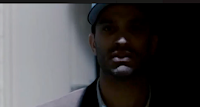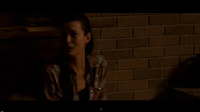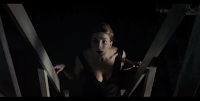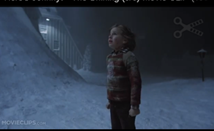Films that have inspired me -
- Prom Night
- Red Eye
- Asylum
- The Strangers
 The film 'Prom Night' inspired me as the killer is wearing a hat and dark clothing in an attempt to hide his identity. This helps to build suspense in the scene, as we do not know who the killer is and neither does the victim. This makes the audience anxious to know who he is and engages them in the scene. This is something I will definitely be using when portraying the killer in my thriller clip.
The film 'Prom Night' inspired me as the killer is wearing a hat and dark clothing in an attempt to hide his identity. This helps to build suspense in the scene, as we do not know who the killer is and neither does the victim. This makes the audience anxious to know who he is and engages them in the scene. This is something I will definitely be using when portraying the killer in my thriller clip. The film 'Red Eye' inspired me because the location is set in an everyday house, specifically in the bathroom for the 'attack' scene, which for me is the most memorable scene. This inspired me because the setting is un-stereotypical to a thriller film, but it still had the same effects as if it were set in a haunted house for example. This setting makes the scene seem realistic, giving the audience something to relate to which is what I aim to do in my thriller clip.
The film 'Red Eye' inspired me because the location is set in an everyday house, specifically in the bathroom for the 'attack' scene, which for me is the most memorable scene. This inspired me because the setting is un-stereotypical to a thriller film, but it still had the same effects as if it were set in a haunted house for example. This setting makes the scene seem realistic, giving the audience something to relate to which is what I aim to do in my thriller clip.
The film 'Asylum' inspired me mainly because there was a lack of iconography and dialogue. The lack of iconography was used in my opinion for dramatic effect to allow the audience to focus on the female and her actions, rather than being distracted by props. This is something I would consider doing in my thriller clip as it meant the audiences full attention was on the characters actions and this meant they were fully engaged and not thinking about other things, allowing them to feel the full effect of the clip.
The lack of dialogue helped build suspense in the clip as it meant the audience were always left sitting on edge, wondering what was to happen next. This film incorporated the 3 S's (Shock, Surprise & Suspense) into their film, which is something that many thrillers do for effect. This is something that I will be using when making my thriller clip as I think it helps to engage the audience.
 When thinking about Mise-en-scene and Cinematography, 'The Strangers' inspired me. This film used cinematography for effect; they used a high angled shot looking down on the character to portray her as the victim, and this built an emotional response from the audience. With Mise-en-scene, the film used low-key lighting as an indicator to the audience of the films genre, and to build a mysterious atmosphere. I will be using Cinematography and Mise-En-Scene in my thriller clip, and will think about how to use them appropriately and for effect.
When thinking about Mise-en-scene and Cinematography, 'The Strangers' inspired me. This film used cinematography for effect; they used a high angled shot looking down on the character to portray her as the victim, and this built an emotional response from the audience. With Mise-en-scene, the film used low-key lighting as an indicator to the audience of the films genre, and to build a mysterious atmosphere. I will be using Cinematography and Mise-En-Scene in my thriller clip, and will think about how to use them appropriately and for effect.
 Body language and facial expressions have been a huge inspiration to me from a variety of different films. They can help the audience understand about a characters personality, how they are feeling and who dominates the scene. They can also show hidden meanings, such as those used in 'Asylum'. In Asylum, the body language of the woman shows her to be standing up tall, with her shoulders back, giving me the impression she is focused and strong-minded. However, her facial expressions show her to be worried, suggesting to me that her strong personality is all an act, and she is only trying to be strong.
Body language and facial expressions have been a huge inspiration to me from a variety of different films. They can help the audience understand about a characters personality, how they are feeling and who dominates the scene. They can also show hidden meanings, such as those used in 'Asylum'. In Asylum, the body language of the woman shows her to be standing up tall, with her shoulders back, giving me the impression she is focused and strong-minded. However, her facial expressions show her to be worried, suggesting to me that her strong personality is all an act, and she is only trying to be strong.
When using body language and facial expressions in my thriller clip, I will think about using them appropriately and whether or not i need to include any hidden meanings.
The lack of dialogue helped build suspense in the clip as it meant the audience were always left sitting on edge, wondering what was to happen next. This film incorporated the 3 S's (Shock, Surprise & Suspense) into their film, which is something that many thrillers do for effect. This is something that I will be using when making my thriller clip as I think it helps to engage the audience.
 When thinking about Mise-en-scene and Cinematography, 'The Strangers' inspired me. This film used cinematography for effect; they used a high angled shot looking down on the character to portray her as the victim, and this built an emotional response from the audience. With Mise-en-scene, the film used low-key lighting as an indicator to the audience of the films genre, and to build a mysterious atmosphere. I will be using Cinematography and Mise-En-Scene in my thriller clip, and will think about how to use them appropriately and for effect.
When thinking about Mise-en-scene and Cinematography, 'The Strangers' inspired me. This film used cinematography for effect; they used a high angled shot looking down on the character to portray her as the victim, and this built an emotional response from the audience. With Mise-en-scene, the film used low-key lighting as an indicator to the audience of the films genre, and to build a mysterious atmosphere. I will be using Cinematography and Mise-En-Scene in my thriller clip, and will think about how to use them appropriately and for effect. Body language and facial expressions have been a huge inspiration to me from a variety of different films. They can help the audience understand about a characters personality, how they are feeling and who dominates the scene. They can also show hidden meanings, such as those used in 'Asylum'. In Asylum, the body language of the woman shows her to be standing up tall, with her shoulders back, giving me the impression she is focused and strong-minded. However, her facial expressions show her to be worried, suggesting to me that her strong personality is all an act, and she is only trying to be strong.
Body language and facial expressions have been a huge inspiration to me from a variety of different films. They can help the audience understand about a characters personality, how they are feeling and who dominates the scene. They can also show hidden meanings, such as those used in 'Asylum'. In Asylum, the body language of the woman shows her to be standing up tall, with her shoulders back, giving me the impression she is focused and strong-minded. However, her facial expressions show her to be worried, suggesting to me that her strong personality is all an act, and she is only trying to be strong.When using body language and facial expressions in my thriller clip, I will think about using them appropriately and whether or not i need to include any hidden meanings.
First individual idea -
My first idea for my thriller film was to be about a child having nightmare. She dreams about being in a park on a swing, happily playing, before the killer takes her.
To make this conventional to a thriller, I have thought about how I would use Cinematography, Iconography, Mise-en-scene and editing.
Firstly, I would set my clip in a detached house and a park which is surrounded with parts of a forest. This is conventional to a thriller as it gives the audience something to relate to, but at the same time is not near anywhere to get help or to escape the killer.
I would use a high angled shot at the beginning of the clip, looking down on the child who is tossing and turning during the nightmare. This will indicate to the audience that she is the victim. To make it clear it is a nightmare, I will use the diegetic sound of the child breathing heavily or of her heartbeat, to build tension. I may also show an eye level shot of her asleep, focusing on the sweat on her face to make it even clearer to the audience.
I would then use an editing technique such as a 'fade' to show the transformation between showing the nightmare and being in the nightmare. I could do this by building the music and sound effects to a climax before the child opens her eyes and everything goes silent. This would focus the audiences attention on the child's eyes, and with the 'fade' would give the impression of going into her dream.
The next frame would be of the child in the park on the swing, playing happily. I could present this emotion through her body language being relaxed and a smile on her face. I would use a mid shot for this and could edit in a non-diegetic sound of the traffic or sounds from the forest, along with the diegetic sound of her laughter.
I would then introduce the killer, by darkening the lighting such as making a clear sky go dark grey and all sounds would stop. I thought a good way to show the killer and still keep his identity hidden would be by showing extreme close ups of the killers body. E.g - His feet & hand. I would then use a deep focus to show the killers shoulder and the girl on the swing in the same shot. This would show the audience the mise-en-scene and also the different representations of the two characters.
For the attack scene, I would use jump cuts of the killer getting closer to the victim, whilst hearing the diegetic sound of leaves crunching beneath his feet and a parallel sound such as eerie music to build the tension. I would only use low key lighting to help keep the killers identity hidden. This also minimises the amount of detail the audience can see, which makes them sit on edge for the following section.
I have thought about using Iconography and dialogue, and have decided to keep this minimal, so the audiences' attention will be focused on the scene. The iconography I will use for my first idea is a knife and a teddy bear. The knife can be shown in the extreme close-up of the killer when he is first introduced, and the teddy bear can be with the child at all times to show her youth.
I am not sure yet how I will use different conventions to end my thriller clip, but the basic idea is for the girl to wake up in her bed, and then have a zooming in shot from her bedroom window to the park outside, where the teddy bear will still be.
My target audience for my thriller clip would be between 15 to mid 20's, but I would give it an age certificate of 15, as strong violence is allowed as long as the film doesn't focus on the infliction of pain/injury. This would suit my narrative as the idea of the girl being taken seems quite violent but you would not actually see this action happen, and so it is simply like an idea. If I was to give my narrative an age certificate of 12 or 18 it would not be as suitable, as a 12 rating states that weapons that are accessible to 12 year old should not be glamorised and since I am using a knife as a key piece of iconography the 12 rating would be too low. Also, an 18 rating has no limits on anything and so since my narrative doesn't go into explicit detail, this would also be inappropriate. I therefore have given my narrative an age certificate of 15 and will focus on the psychological impact, rather than the gruesome and blood.
I would then use an editing technique such as a 'fade' to show the transformation between showing the nightmare and being in the nightmare. I could do this by building the music and sound effects to a climax before the child opens her eyes and everything goes silent. This would focus the audiences attention on the child's eyes, and with the 'fade' would give the impression of going into her dream.
The next frame would be of the child in the park on the swing, playing happily. I could present this emotion through her body language being relaxed and a smile on her face. I would use a mid shot for this and could edit in a non-diegetic sound of the traffic or sounds from the forest, along with the diegetic sound of her laughter.
I would then introduce the killer, by darkening the lighting such as making a clear sky go dark grey and all sounds would stop. I thought a good way to show the killer and still keep his identity hidden would be by showing extreme close ups of the killers body. E.g - His feet & hand. I would then use a deep focus to show the killers shoulder and the girl on the swing in the same shot. This would show the audience the mise-en-scene and also the different representations of the two characters.
For the attack scene, I would use jump cuts of the killer getting closer to the victim, whilst hearing the diegetic sound of leaves crunching beneath his feet and a parallel sound such as eerie music to build the tension. I would only use low key lighting to help keep the killers identity hidden. This also minimises the amount of detail the audience can see, which makes them sit on edge for the following section.
I have thought about using Iconography and dialogue, and have decided to keep this minimal, so the audiences' attention will be focused on the scene. The iconography I will use for my first idea is a knife and a teddy bear. The knife can be shown in the extreme close-up of the killer when he is first introduced, and the teddy bear can be with the child at all times to show her youth.
I am not sure yet how I will use different conventions to end my thriller clip, but the basic idea is for the girl to wake up in her bed, and then have a zooming in shot from her bedroom window to the park outside, where the teddy bear will still be.
My target audience for my thriller clip would be between 15 to mid 20's, but I would give it an age certificate of 15, as strong violence is allowed as long as the film doesn't focus on the infliction of pain/injury. This would suit my narrative as the idea of the girl being taken seems quite violent but you would not actually see this action happen, and so it is simply like an idea. If I was to give my narrative an age certificate of 12 or 18 it would not be as suitable, as a 12 rating states that weapons that are accessible to 12 year old should not be glamorised and since I am using a knife as a key piece of iconography the 12 rating would be too low. Also, an 18 rating has no limits on anything and so since my narrative doesn't go into explicit detail, this would also be inappropriate. I therefore have given my narrative an age certificate of 15 and will focus on the psychological impact, rather than the gruesome and blood.















